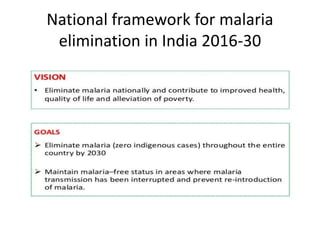NVBDCP---- Dr.Himanshusinh
- 1. National Health Programme Why National Health programme? GEOGRPAHICAL SPREAD DISEASE BURDEN IS HIGH PROVEN STRATEGIES FOR PREVENTION AND CONTROL ARE AVAILABLE ADEQUATE INFRASTRUCTURE IS IN PLACE RESOURCES FOR PROGRAMME IMPELMENATION ARE AVAILABLE.
- 2. Programmes for Communicable Diseases 1. National Vector Borne Diseases Control Programme (NVBDCP) 2. National Leprosy Eradication 3. National AIDS Control Programme 4. Revised National Tuberculosis Control Programme 5. Universal Immunization Programme 6. National Guinea worm Eradication Programme 7. Yaws Control Programme 8. Integrated Disease Surveillance Programme
- 3. NATIONAL VECTOR BORNE DISEASE CONTROL PROGRAMME (NVBDCP) & NATIONAL MALARIA CONTROL PROGRAMME
- 6. Introduction
- 7. • NATIONAL ANTI-MALARIA PROGRAMME 1999 &NATIONAL VECTOR BORNE DISEASE CONTROLPROGRAMME 2004 • OBJECTIVES: • REDUCE MALARIA MORBIDITY AND MORTALITY BY 50%TARGETS • INDICATORS: ABER>10% MBER OF 0.8%1.2 – 1.8% API 1.3 OR LESS 25% REDUCTION IN MORBIDITY AND MORTALITY BY 2010 50% REDUCTION IN MORBIDITY AND MORTALITY BY 2012
- 9. Strategies: Malaria • Early case detection and prompt treatment (EDPT) – Clinically suspected malaria cases are confirmed on microscopy or rapid diagnostic kits(RDK) – Drug Distribution Center (DDC) and Fever Treatment Depots(FTD) have been established in rural areas – In inaccessible areas, Health agencies and volunteers running FTD’s are provided with RDK’s
- 10. Mission Statement • Integrated accelerated action towards – Reducing mortality on account of Malaria, Dengue and JE by half – Elimination of Kala‐azar by 2010 – Elimination of lymphatic filariasis by year 2015.
- 11. MALARIA • Malaria is a potentially life threatening parasitic disease caused by parasites known as Plasmodium viviax (P.vivax), • Plasmodium falciparum (P.falciparum), • Plasmodium malariae (P.malariae) and • Plasmodium ovale (P.ovale) • It is transmitted by the infective bite of Anopheles mosquito • Man develops disease after 10 to 14 days of being bitten by an infective mosquito
- 13. World Malaria Day -25th April • World Malaria Day - which was instituted by the World Health Assembly at its 60th session in May 2007. • World Malaria Day 2012- “SUSTAIN GAINS, SAVE LIVES: INVEST IN MALARIA” marks a decisive juncture in the history of malaria control.
- 14. Milestones of Malaria control activities in India
- 16. Classification of Endemic Areas Annual Parasite Incidence (API) More than 2 Annual Parasite Incidence (API) Less than 2 •Spraying of all areas •Entomological assessment •Surveillance: • Active surveillance •Passive surveillance •Treatment of cases •Spraying: focal spraying • Surveillance: more vigorously •Treatment •Follow‐up •Epidemiological investigation
- 17. Algorithm for Diagnosis & Treatment of Malaria
- 20. Global Strategic action plan 2016-30
- 21. National framework for malaria elimination in India 2016-30
- 28. Incentives to ASHAs under NVBDCP
- 29. INTEGRATED VECTOR MANAGEMENT • Source reduction, filling, streamlining water bodies – Biological Control‐Gambusia Fishes & Biolarvicides (Bacillus sphaericus) – Impregnated bed nets – DDT spraying. – IEC campaigns
- 30. Urban Malaria Schemes • OBJECTIVES: • The main aim is the reduction of the disease to a tolerable level in which the human population can be protected from malaria transmission with the available means. • The Urban Malaria Scheme aims at : a) To prevent deaths due to malaria. b) Reduction in transmission and morbidity.
- 31. Control Strategies under Urban Malaria Scheme: Vector Control – 1) Source Reduction 2) Anti-larval methods- Chemical Recurrent anti- larval measures at weekly intervals with approved chemical larvicides like Temephos. 3)Use of larvivorous fish like gambusia and guppy 4)Aerosol space spray – 5) Minor engineering&Legislative measures
- 32. Monitoring Malaria incidence trends and geographic distribution 1) Active Surveillance(Active case detection) 2) Passive Surveillance (PCD) 3) Sentinel Surveillance
- 33. Malaria is under Regular Surveillance in Integrated Disease Surveillance Project(IDSP) • Case Classification: Suspect case- Any case of fever(in an endemic area). • Probable case- A case that meets the clinical case description. • Confirmed case- A suspect case with malaria parasites in blood film.






































